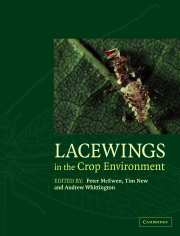Book contents
- Frontmatter
- Contents
- List of contributors
- Preface
- PART 1 Lacewing systematics and ecology
- PART 2 Lacewings in crops
- Introduction to Part 2
- CHAPTER 8 Lacewings in field crops
- CHAPTER 9 Lacewings in fruit and nut crops
- CHAPTER 10 Lacewings in vegetables, forests, and other crops
- PART 3 Principles
- PART 4 Case studies
- PART 5 Conclusion
- Taxonomic index
- General index
CHAPTER 10 - Lacewings in vegetables, forests, and other crops
Published online by Cambridge University Press: 04 May 2010
- Frontmatter
- Contents
- List of contributors
- Preface
- PART 1 Lacewing systematics and ecology
- PART 2 Lacewings in crops
- Introduction to Part 2
- CHAPTER 8 Lacewings in field crops
- CHAPTER 9 Lacewings in fruit and nut crops
- CHAPTER 10 Lacewings in vegetables, forests, and other crops
- PART 3 Principles
- PART 4 Case studies
- PART 5 Conclusion
- Taxonomic index
- General index
Summary
VEGETABLES
The vegetable crops discussed here are grown mainly in smaller plots, in house gardens, and greenhouses although some of them are also field crops. Many pests live on vegetables, but knowledge of associated lacewings as natural enemies of these is sparse.
Various cultivars of bean (Phaseolus vulgaris) are produced world-wide. Both larvae and adults of the following lacewing species were collected from aphid (Aphis fabae complex) infested bean plants in a garden in Hungary: Chrysoperla carnea, Chrysopa formosa, Micromus angulatus, and M. variegatus (F. Szentkirályi, unpublished data). Chrysoperla carnea was a predator of the mite Tetranychus urticae on beans in Turkey (Aydemir & Toros, 1990). The brown lacewing M. timidus occurs in colonies of A. craccivora infesting bean plantations in Western Samoa (Stechmann & Semisi, 1984). Pantaleoni & Tisselli (1985) sampled potential biological control agents by sweep-netting on stands of Vicia faba in Italy. Five chrysopid species were recorded with percentage of species incidence as follows: Dichochrysa prasina (44%), Chrysopa formosa (27.7%), Chrysoperla carnea (23.4%), D. clathrata (2.8%), and Chrysopa pallens (2.1%). The presence of arboreal Dichochrysa spp. on beans reflects that surrounding vegetation acts as a lacewing reservoir, while the presence of Chrysoperla carnea and Chrysopa formosa may be related to lacewing species associated with phytophagous insects and mites of bean plantations.
Cabbage (Brassica oleracea) also has numerous aphid pests. Chrysopa perla was one of the most important natural enemies of Brevicoryne brassicae in cabbage fields in the Moscow area (Russia) (Ter-Simonjan et al., 1982). Somen-Singh et al. (1994) demonstrated that the aphidophagous M. timidus was among the natural enemies of the key pest Myzus persicae on cabbage in India.
- Type
- Chapter
- Information
- Lacewings in the Crop Environment , pp. 239 - 292Publisher: Cambridge University PressPrint publication year: 2001
- 16
- Cited by



